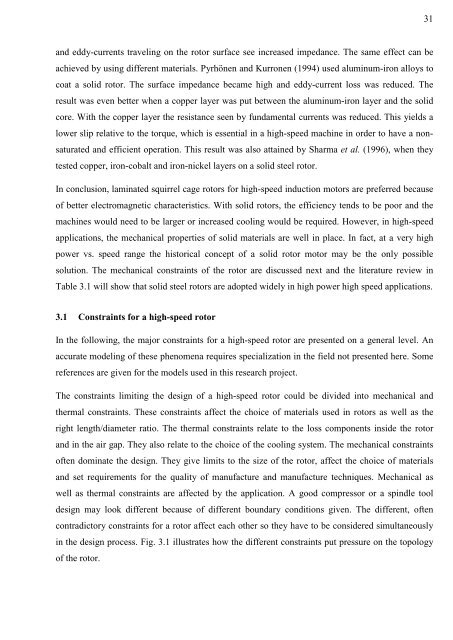Design and Voltage Supply of High-Speed Induction - Aaltodoc
Design and Voltage Supply of High-Speed Induction - Aaltodoc
Design and Voltage Supply of High-Speed Induction - Aaltodoc
Create successful ePaper yourself
Turn your PDF publications into a flip-book with our unique Google optimized e-Paper software.
<strong>and</strong> eddy-currents traveling on the rotor surface see increased impedance. The same effect can be<br />
achieved by using different materials. Pyrhönen <strong>and</strong> Kurronen (1994) used aluminum-iron alloys to<br />
coat a solid rotor. The surface impedance became high <strong>and</strong> eddy-current loss was reduced. The<br />
result was even better when a copper layer was put between the aluminum-iron layer <strong>and</strong> the solid<br />
core. With the copper layer the resistance seen by fundamental currents was reduced. This yields a<br />
lower slip relative to the torque, which is essential in a high-speed machine in order to have a nonsaturated<br />
<strong>and</strong> efficient operation. This result was also attained by Sharma et al. (1996), when they<br />
tested copper, iron-cobalt <strong>and</strong> iron-nickel layers on a solid steel rotor.<br />
In conclusion, laminated squirrel cage rotors for high-speed induction motors are preferred because<br />
<strong>of</strong> better electromagnetic characteristics. With solid rotors, the efficiency tends to be poor <strong>and</strong> the<br />
machines would need to be larger or increased cooling would be required. However, in high-speed<br />
applications, the mechanical properties <strong>of</strong> solid materials are well in place. In fact, at a very high<br />
power vs. speed range the historical concept <strong>of</strong> a solid rotor motor may be the only possible<br />
solution. The mechanical constraints <strong>of</strong> the rotor are discussed next <strong>and</strong> the literature review in<br />
Table 3.1 will show that solid steel rotors are adopted widely in high power high speed applications.<br />
3.1 Constraints for a high-speed rotor<br />
In the following, the major constraints for a high-speed rotor are presented on a general level. An<br />
accurate modeling <strong>of</strong> these phenomena requires specialization in the field not presented here. Some<br />
references are given for the models used in this research project.<br />
The constraints limiting the design <strong>of</strong> a high-speed rotor could be divided into mechanical <strong>and</strong><br />
thermal constraints. These constraints affect the choice <strong>of</strong> materials used in rotors as well as the<br />
right length/diameter ratio. The thermal constraints relate to the loss components inside the rotor<br />
<strong>and</strong> in the air gap. They also relate to the choice <strong>of</strong> the cooling system. The mechanical constraints<br />
<strong>of</strong>ten dominate the design. They give limits to the size <strong>of</strong> the rotor, affect the choice <strong>of</strong> materials<br />
<strong>and</strong> set requirements for the quality <strong>of</strong> manufacture <strong>and</strong> manufacture techniques. Mechanical as<br />
well as thermal constraints are affected by the application. A good compressor or a spindle tool<br />
design may look different because <strong>of</strong> different boundary conditions given. The different, <strong>of</strong>ten<br />
contradictory constraints for a rotor affect each other so they have to be considered simultaneously<br />
in the design process. Fig. 3.1 illustrates how the different constraints put pressure on the topology<br />
<strong>of</strong> the rotor.<br />
31
















